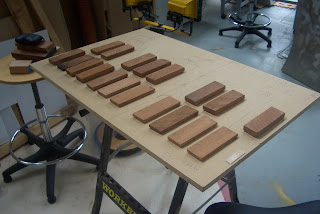Last week we contacted composer and musician Oyvind Brandtsegg to gather his thoughts and advice on our thesis. Oyvind's interest is in the dsign of custom musical instruments with computers using sensor technology. He's also a vibraphone and marimba player, among other things. He was very keen to lend his advice.
He currently uses a Marimba Lumina(http://www.buchla.com/mlumina/index.html), and he's quite happy with it. He has it customized for lower latency but the only things he's not quite happy with is that it doesnt allow for heavy hitting. He feels that the marimba doesnt always need to be hit hard but he would like to sometime use the full dynamic range. Myself and Dave feel that heavy hitting is not something we are very concerned with in our prototype.
He then went on to describe his Marimba Lumina in more detail, describing the customisation of the 4 mallets.
" * I let each mallet send on a separate midi channel, and I let each
mallet send a midi control change message (I use contr numbers
1,2,3,4, but it could be any control change message).
* The control change is sent on relative movement along the tone bar,
much like a midi fader. Relative movement is most comfortable for me,
as I can hit the tone bar in any location and move from there to send
control change. All midi are routed to Csound in my laptop, I will
tell more about how the controller messages are used later.
* I have also set up the ML so that the length of the midi note event
is longer if I hit the tone bar at the end far away from me, and more
staccato if I hit the end of the tone bar closer to me.
* The ML has 5 pedal inputs, and I use one for sustain (normal midi
keyboard sustain). I use another as a regular midi expression pedal,
sending midi control messages on ctrl no 7. I use a third pedal to
transpose mallet 1 down one octave, and at the same time mallet 4 up
one octave (this greatly extends the pitch range of the instrument and
also is nice when playing chords with a "bass note" and a "melody
note"). I use a fourth pedal as a "mono" switch: setting mallet 1 to
be monophonic, mallet 4 to be monophonic, and mallets 3&4 to be
"combined monophonic". Is the mono mode I can then play only 3
simultaneous notes, but I do not have to worry at all about damping.
Csound:
I use csound as my only sound source for live applications and I have
a collection of instruments (vibes, marimba, clavinet, mellotron,
analogsynths etc). Normally the control change from mallet 4 will act
as pitchbend up (but only on the notes played by mallet 4, all notes
played by other mallets are not bent). Control change on mallet 3 are
pitchbend up for all notes regardless of what mallet did play them.
Control change on mallet 2 act as pitchbend down on all notes, and
control change on mallet 1 act as a "expression" parameter (e.g.
filter cutoff frequency, ringmodulation amount, or other timbral
variation).
The ML also has some extra "pads" that can be used as midi notes. I
have assigned these pads to different control functions, e.g. start or
stop recording, start or stop a sequencer master clock, turn on/off
algorithmically generated voices and so on.
I use an assortment of extra expression pedals (5 or 6) to control
effect sends etc, these pedals are connected to a Roland FC200 (I
think that's the model number, I do not have it here right now) which
I also use for patch change (instrument change).
I have experimented with using different timbres on the different
mallets, but I do not use that a lot."
Also added that he doesnt know of any cheaper instruments. As far as alternatives to the ML goes he mentioned the MalletKat and the Xylosynth but these dont differentiate between mallets like the ML.
Thanks to Oyvind for more than enough information.
He hopes to be over in November for the Sounds Electric Conference.
Chris H





